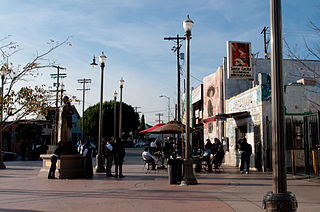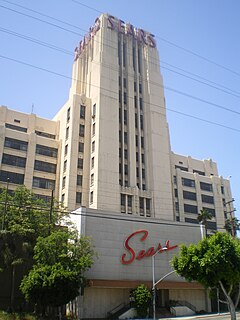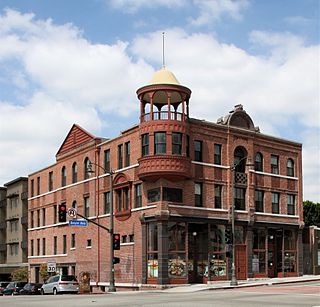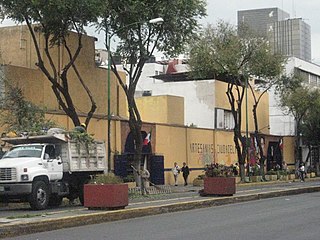
The music of Mexico is very diverse and features a wide range of musical genres and performance styles. It has been influenced by a variety of cultures, most notably the culture of the indigenous people of Mexico and Europe. Music was an expression of Mexican nationalism, beginning in the nineteenth century.

Mariachi is a genre of Regional Mexican music that dates back to at least the 18th century, evolving over time in the countryside of various regions of western Mexico. The usual mariachi group today consists of as many as eight violins, two trumpets and at least one guitar, including a high-pitched vihuela and an acoustic bass guitar called a guitarrón, and all players taking turns singing lead and doing backup vocals.

Boyle Heights is a neighborhood of almost 100,000 residents in Los Angeles, California.

María Guadalupe Araujo, better known as Ana Gabriel, is a Mexican singer and songwriter from Comanito, Sinaloa, Mexico. She first sang on the stage at age six, singing "Regalo A Dios" by José Alfredo Jiménez. She moved to Tijuana, Baja California and studied accounting. At age 21, in 1977, she recorded her first song, titled "Compréndeme". During her long career, she has hits in three different genres of music: Latin pop, Latin rock, and Mariachi.

The Eastside is an urban region in eastern Los Angeles County, California.

Mercado Libre, Inc. is an Argentine company incorporated in the United States that operates online marketplaces dedicated to e-commerce and online auctions, including mercadolibre.com. As of 2016, Mercado Libre had 174.2 million users in Latin America, making it the region's most popular e-commerce site by number of visitors. The company has operations in Argentina, Bolivia, Brazil, Chile, Colombia, Costa Rica, Dominican Republic, Mexico, España, Ecuador, Guatemala, Honduras, Peru, Panama, Uruguay and Venezuela.

A remittance is a transfer of money, often by a foreign worker to an individual in their home country. Money sent home by migrants competes with international aid as one of the largest financial inflows to developing countries. Workers' remittances are a significant part of international capital flows, especially with regard to labor-exporting countries.
Nydia Rojas, is an American singer who performs in a wide range of musical styles such as jazz, soul, and R&B, but makes a particular specialty of Mexican folk music.

José L. Hernández is a Mexican mariachi musician.
Mariachi los Camperos de Nati Cano is a Grammy Award-winning Los Angeles-based mariachi ensemble which was formerly led by Natividad "Nati" Cano.

Mariachi Plaza is located in the Boyle Heights district of the city of Los Angeles, east of downtown. Since the 1930s, mariachi musicians have gathered in hopes of being hired by visitors who are looking for a full band, trio or solo singer. The plaza resembles Mexico's famed Plaza Garibaldi in both form and function. This plaza is also an historic gateway to the neighborhood.
"Gifting remittances" describes a range of scholarly approaches relating remittances to anthropological literature on gift giving. The terms draws on Lisa Cliggett's "gift remitting", but is used to describe a wider body of work. Broadly speaking, remittances are the money, goods, services, and knowledge that migrants send back to their home communities or families. Remittances are typically considered as the economic transactions from migrants to those at home. While remittances are also a subject of international development and policy debate and sociological and economic literature, this article focuses on ties with literature on gifting and reciprocity or gift economy founded largely in the work of Marcel Mauss and Marshall Sahlins. While this entry focuses on remittances of money or goods, remittances also take the form of ideas and knowledge. For more on these, see Peggy Levitt's work on "social remittances" which she defines as "the ideas, behaviors, identities, and social capital that flow from receiving to sending country communities."

The Sears, Roebuck & Company product distribution center in Boyle Heights, Los Angeles, California, is a historic landmark that was one of the company's mail-order facilities, with a retail store on the ground floor.
Soto Street is a major north-south thoroughfare in Los Angeles, California, connecting the southernmost neighborhoods of the Eastside, as well as the southeastern suburbs of Vernon and Huntington Park.
Lummis Day is a signature community arts and music event in the neighborhoods of Northeast Los Angeles, showcasing the community's considerable pool of musicians, poets, artists, dancers and restaurants representing a kaleidoscope of ethnicities and cultural traditions. Since 2014, Occidental College's Institute for the Study of Los Angeles has partnered with the Lummis Day Community Foundation to support cultural programming.

The historic 1889 Boyle Hotel is across the street from the Mariachi Plaza at the corner of Boyle Avenue, First Street and Pleasant Avenue in the East Los Angeles community of Boyle Heights. The building was formerly a hotel and commercial shops line the first floor of this Queen Anne Style building. In 2007 the building was declared a Los Angeles Cultural Monument.

The Ciudadela Market is a traditional style Mexican market which specializes in the sale of Mexican handcrafts and folk art, located in the southwest corner of the historic center of Mexico City. The market is the first of its kind in the country, established just before the 1968 Summer Olympics to promote this aspect of Mexico’s cultural heritage. It is home to over 350 vendors, mostly small operators selling to Mexican and foreign tourists.
Hometown associations (HTAs), also known as hometown societies, are social alliances that are formed among immigrants from the same city or region of origin.Their purpose is to maintain connections with and provide mutual aid to immigrants from a shared place of origin. They may also aim to produce a new sense of transnational community and identity rooted in the migrants' country of origin, extending to the country of settlement. People from a variety of places have formed these associations in several countries, serving a range of purposes.
International money transfers made by migrant workers and immigrants sending a portion of their earnings to their families in their country of origin are known as remittances. Remittances are an important aspect of the global economy, totaling an estimated $601 billion (USD) for the year 2015. The United States is currently the largest source of international remittances in the world, sending a total of $56.3 billion in 2015. Mexico received the largest portion of these remittances, accounting for an estimated $25.2 billion, making the U.S.-Mexico remittance corridor one of the largest in the world. With the exception of the 2008 global financial crisis, remittances sent from the U.S. have been consistently climbing for the past half century. This major increase in remittances can be partially attributed to the larger population of immigrants and migrant workers, as well as to increasing globalization in the financial and money markets. China and India are also major recipients of U.S. remittances, and are the top two recipients of remittances globally.
El Tepeyac Café, or simply El Tepeyac, is a longstanding Mexican restaurant in the Boyle Heights neighborhood of East Los Angeles. They are famous for their massive burritos, “Manuel’s Special Burrito” and the “Hollenbeck Burrito.” The original location is located at 812 North Evergreen Avenue, Los Angeles, CA 90033. Its secondary location is located at 13131 Crossroads Pkwy S, City of Industry, CA 91746











